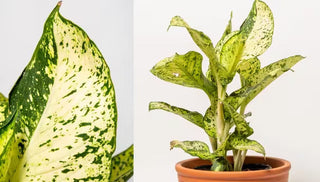Native to the tropics of the Caribbean and South America, dieffenbachias are cherished for their large, lush leaves, which brighten up shady corners with their striking ivory and green patterns. Dieffenbachia are members of the Araceae family, which also contains the equally popular Caladium and Aglaonema. Collectively, all dieffenbachia are also referred to by the common name "dumb cane", due to the mouth-numbing toxic sap that can ooze from cut stems. However that name has fallen out of favor in recent years — this plant may also go by "leopard lily" or simply "dieffenbachia".
Types of Dieffenbachia
There are dozens of dieffenbachia species and cultivars, however only a small fraction are sold as houseplants.
Dieffenbachia seguine: Native to Brazil, this is arguably the most widely available dieffenbachia. It features wide, green leaves with cream-colored splotches down the center vein.
Dieffenbachia amoena 'Camille': This cultivar has gorgeous ivory leaves with dark green edges, and grows in a fuller, bushier form.
Dieffenbachia amoena 'Tropic Snow': A taller variety that can easily top 6 feet in height, this plant has green and ivory leavees.
Dieffenbachia amoena 'Tropical Tiki': This variety has wildly speckled leaves in shades of green, grey, white, and silver.
Best Growing Conditions for Dieffenbachia
Light
In their tropical habitat, dieffenbachia are found in dappled sunlight that filters through the upper tree canopy. Dieffenbachias thrive in bright, indirect light but can tolerate lower light conditions. Direct sunlight, can scorch their leaves, so it's best to keep them away from south-facing windows. Rotate your dieffenbachia occasionally to encourage even, upright growth.
Soil
A chunky, well-draining potting mix is ideal for these plants. Combining regular potting soil with perlite or orchid bark can improve drainage. Fertilize every four to six weeks during the growing season with a balanced, water-soluble fertilizer but reduce this in the winter.
Humidity
Like most tropical plants, dieffenbachia prefer higher than average humidity. Place in a moist bathroom or try placing your pot on a dish of pebbles and a little water
How To Care for Dieffenbachia
Watering
Water your Dieffenbachia when the top inch of the soil feels dry. Avoid overwatering to prevent root rot. Scale back on watering during the cooler months.
Pruning
While regular pruning isn't mandatory, trimming off yellow or damaged leaves can be beneficial. Pruning may also promote bushier growth. Always use clean, sharp scissors or pruning shears.
Repotting
Dieffenbachia are relatively fast-growing, and may require a frequent upgrade in pot size. Consider repotting Dieffenbachias every 1-2 years or when they become root-bound, preferably in the spring. Choose a pot slightly larger than the current one with good drainage.
Propagation
Propagation is usually done through stem cuttings. Place a cut stem in water or moist soil, and it should root within a few weeks. This is an excellent way to multiply your collection or share with fellow gardening enthusiasts.
Common Problems with Dieffenbachias
Pests and Diseases
Watch out for common pests like spider mites, mealybugs, and aphids. Treat infestations promptly with insecticidal soap or neem oil. Overwatering can lead to fungal diseases like root rot, so be vigilant about your watering schedule.
Toxicity
Dieffenbachias are toxic to both pets and humans. Additionally, the sap can cause skin irritation, so it's recommended to wear gloves when pruning this plant.
Dieffenbachia FAQs
Q: How can I tell if my Dieffenbachia needs more light?
A: Dieffenbachia love a bright room. If the plant's leaves become less vibrant and less variegated, and the new leaves are smaller, it might be a sign that it needs more light. Avoid direct sunlight, but move to a brighter room.
Q: Why are Dieffenbachia also called "Dumb Cane" plants?
A: Dieffenbachia plants contain a calcium oxalate -based sap that causes mouth swelling if consumed, earning it the moniker "Dumb Cane." Keep kids and pets away from this plant, and remember to wash your hands after any pruning.
Q: Is it normal for the lower leaves of my Dieffenbachia to fall off?
A: It's normal for the lower leaves to shed as the plant grows and ages. However, excessive leaf drop could indicate a problem with watering — crinkling, dry leaves that drop mean the plant needs more water, while leaves that drop and leave behind a slimy branch mean the plant has been overwatered. Adjust your watering habits!
Looking for a lush tropical vibe? Dieffenbachia are sure to elevate your space to "rainforest" status with their large leaves in splashy patterns of green and white. Group several together to brighten up a boring corner of your home (grouping plants together can also help boost humidity, a big plus for these tropical natives), and don't be shy about trying a different variety — there are plenty to admire!




